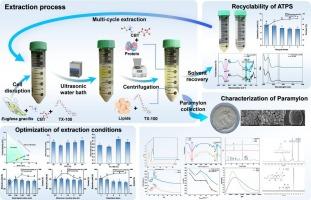Paramylon biorefinery from Euglena gracilis via recyclable aqueous two-phase system: A sustainable platform for high-content β-1,3-glucan production
IF 12.5
1区 化学
Q1 CHEMISTRY, APPLIED
引用次数: 0
Abstract
Paramylon is a prospective, promising β-1,3-glucan source due to its diverse bioactive properties, sustainable production, and high yield. A green aqueous two-phase system (ATPS) composed of Triton X-100 (TX-100) and choline bitartrate (CBT) was established to extract paramylon. The process was optimized via single-factor experiments and response surface methodology. Optimized ATPS achieved a paramylon (marked as Pa-2) yield of 75.47 ± 0.46 % (dry weight) and content of 94.36 ± 0.22 %, surpassing conventional SDS + Na₂EDTA extraction (87.61 ± 0.41 %, marked as Pa-1). Crucially, TX-100 and CBT were recycled 5 times with recovery rates of 79.31 % and 85.73 %, respectively. Structural analyses confirmed the β-1,3-glucan identity for both extracts. GPC analysis revealed that the average molecular weight mass of Pa-1 and Pa-2 were 137,700 g/mol and 171,946 g/mol, respectively. Congo red and XRD analysis studies demonstrated that Pa-2 exhibited a more complete triple helix structure and an enhanced crystal structure compared to Pa-1. The aforementioned research demonstrated that ATPS-based TX-100/CBT can be employed to extract paramylon from Euglena gracilis as a green, sustainable, and efficient method.

利用可循环双水相系统从绿枝藻中提纯Paramylon:一个可持续的高含量β-1,3-葡聚糖生产平台
Paramylon具有丰富的生物活性、可持续生产和高产等优点,是一种很有前途的β-1,3-葡聚糖来源。建立了由Triton X-100 (TX-100)和双酒石酸胆碱(CBT)组成的绿色双水相体系(ATPS)来提取paramylon。通过单因素试验和响应面法对工艺进行优化。优化后的ATPS得到的paramylon(标记为Pa-2)得率为75.47±0.46%(干重),含量为94.36±0.22%,优于传统的SDS + Na₂EDTA提取(87.61±0.41%,标记为Pa-1)。重要的是,TX-100和CBT回收5次,回收率分别为79.31%和85.73%。结构分析证实了两种提取物的β-1,3-葡聚糖同源性。GPC分析表明,Pa-1和Pa-2的平均分子量质量分别为137,700 g/mol和171,946 g/mol。刚果红和XRD分析表明,与Pa-1相比,Pa-2具有更完整的三螺旋结构和增强的晶体结构。上述研究表明,基于atps的TX-100/CBT可作为一种绿色、可持续、高效的方法提取青叶草中的paramylon。
本文章由计算机程序翻译,如有差异,请以英文原文为准。
求助全文
约1分钟内获得全文
求助全文
来源期刊

Carbohydrate Polymers
化学-高分子科学
CiteScore
22.40
自引率
8.00%
发文量
1286
审稿时长
47 days
期刊介绍:
Carbohydrate Polymers stands as a prominent journal in the glycoscience field, dedicated to exploring and harnessing the potential of polysaccharides with applications spanning bioenergy, bioplastics, biomaterials, biorefining, chemistry, drug delivery, food, health, nanotechnology, packaging, paper, pharmaceuticals, medicine, oil recovery, textiles, tissue engineering, wood, and various aspects of glycoscience.
The journal emphasizes the central role of well-characterized carbohydrate polymers, highlighting their significance as the primary focus rather than a peripheral topic. Each paper must prominently feature at least one named carbohydrate polymer, evident in both citation and title, with a commitment to innovative research that advances scientific knowledge.
 求助内容:
求助内容: 应助结果提醒方式:
应助结果提醒方式:


